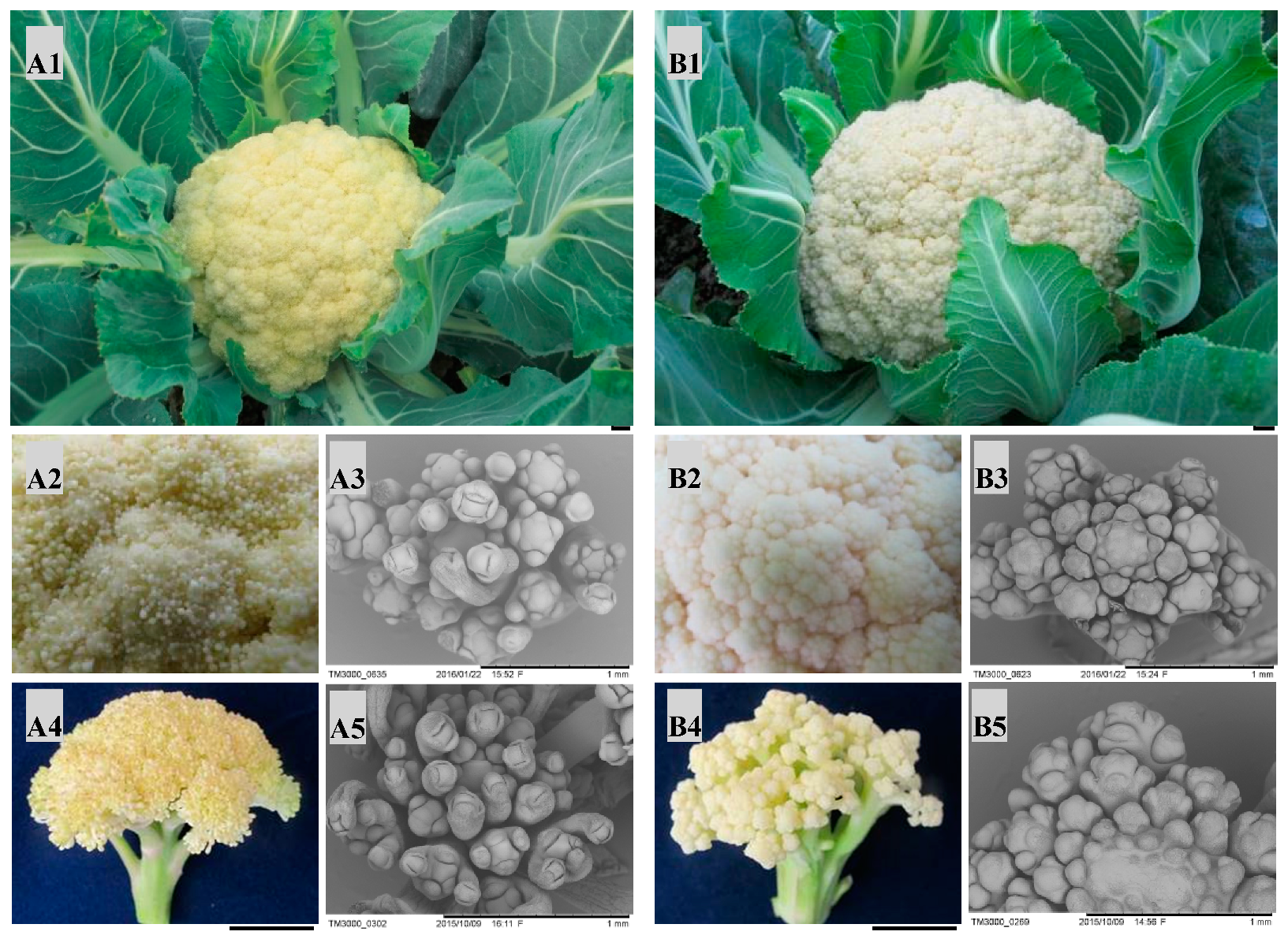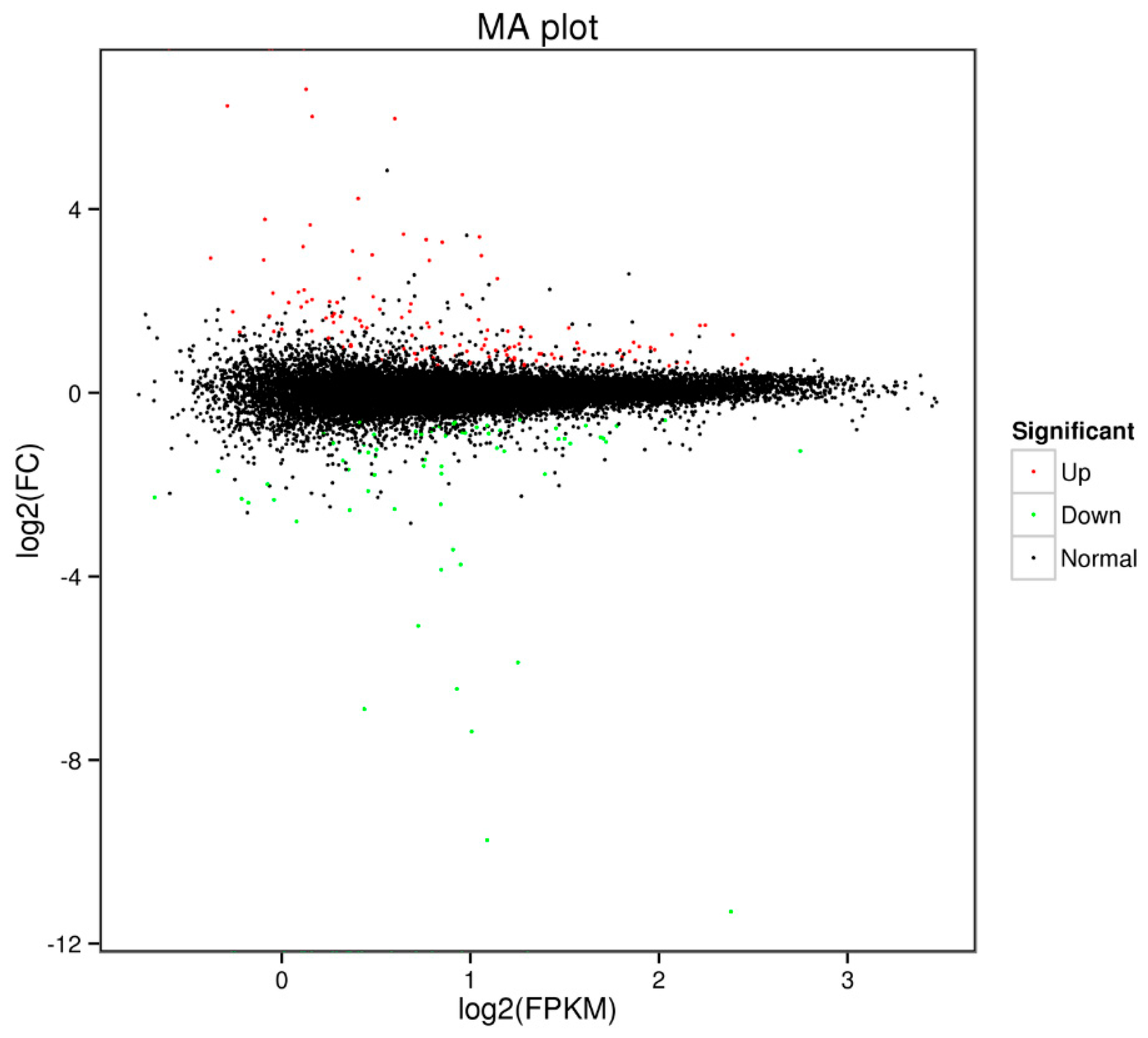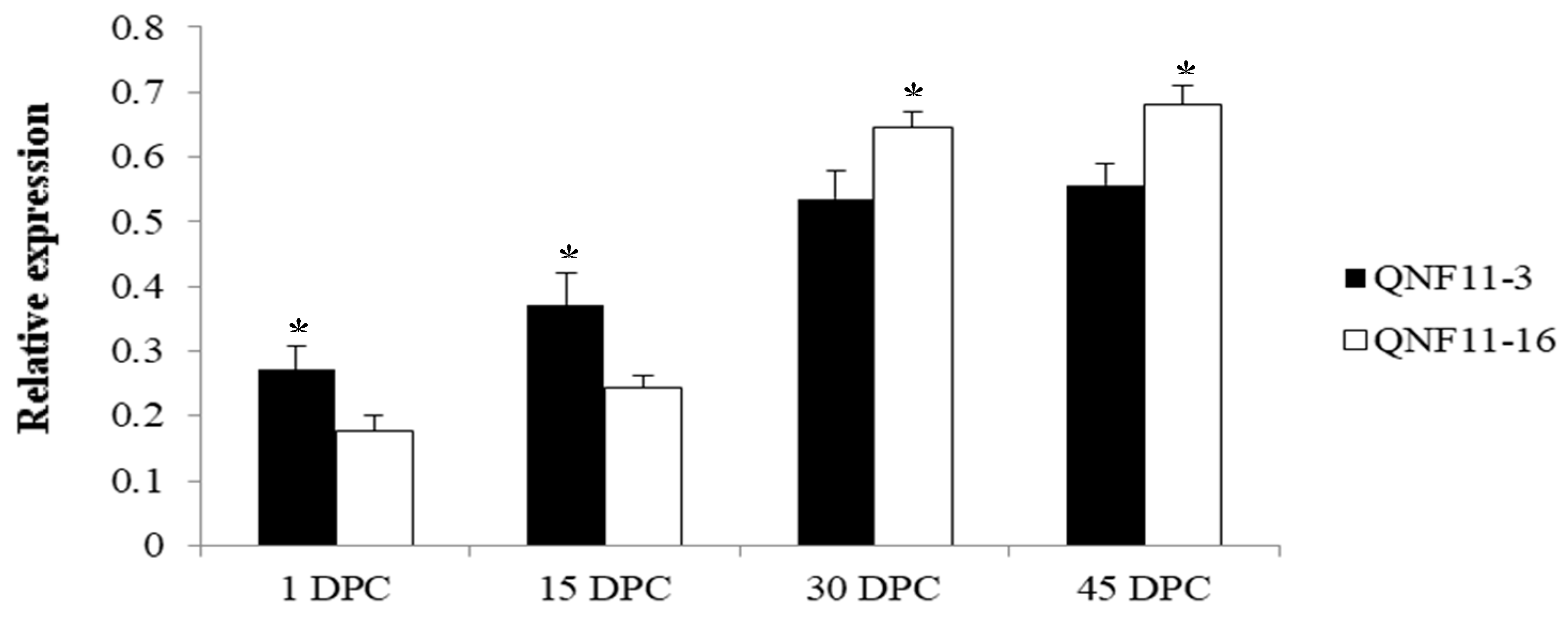Identification of Candidate Genes Involved in Curd Riceyness in Cauliflower
Abstract
:1. Introduction
2. Results
2.1. Phenotypic Variation and Genetic Analysis
2.2. Genetic Mapping of Riceyness
2.3. Transcriptome Differences between Ricey and Non-Ricey Parents
2.4. Identification of Candidate Genes
3. Discussion
4. Materials and Methods
4.1. Plant Materials and Phenotype Determination
4.2. Genomic DNA Isolation and Bulking
4.3. Genome Sequencing and Analysis
4.4. RNA-Seq Analysis
Availability of Supporting Data
Supplementary Materials
Author Contributions
Funding
Conflicts of Interest
References
- Watts, L.E. Conformation of cauliflower curds. Euphytica 1966, 15, 111–115. [Google Scholar]
- Carr, S.M.; Irish, V.F. Floral homeotic gene expression defines developmental arrest stages in Brassica oleracea vars. botrytis and italica. Planta 1997, 201, 179–188. [Google Scholar] [PubMed]
- Ridge, S.; Brown, P.; Hecht, V.; Driessen, R.; Weller, J. The role of boflc2 in cauliflower (Brassica oleracea var. botrytis L.) reproductive development. J. Exp. Bot. 2015, 66, 125–135. [Google Scholar] [PubMed] [Green Version]
- Ferrandiz, C. Redundant regulation of meristem identity and plant architecture by FRUITFULL, APETALA1 and CAULIFLOWER. Development 2000, 127, 725–734. [Google Scholar] [CrossRef] [PubMed]
- Kempin, S.; Savidge, B.; Yanofsky, M. Molecular basis of the cauliflower phenotype in Arabidopsis. Science 1995, 267, 522–525. [Google Scholar] [CrossRef] [PubMed]
- Kieffer, M.; Fuller, M.P.; Jellings, A.J. Explaining curd and spear geometry in broccoli, cauliflower and romanesco: Quantitative variation in activity of primary meristems. Planta 1998, 206, 34–43. [Google Scholar] [CrossRef]
- Blümel, M.; Dally, N.; Jung, C. Flowering time regulation in crops-what did we learn from Arabidopsis? Curr. Opin. Biotech. 2015, 32, 121–129. [Google Scholar] [CrossRef]
- Watts, L.E. Investigations on the inheritance and responses to selection of riceyness in early summer cauliflower. Euphytica 1966, 15, 90–98. [Google Scholar]
- Bowman, J.L.; Alvarez, J.; Weigel, D.; Meyerowitz, E.M.; Smyth, D.R. Control of flower development in Arabidopsis thaliana by APETALA1 and interacting genes. Development 1991, 119, 721–743. [Google Scholar]
- Smith, L.B.; King, G.J. The distribution of BoCAL-a alleles in Brassica oleracea is consistent with a genetic model for curd development and domestication of the cauliflower. Mol. Breed. 2000, 6, 603–613. [Google Scholar] [CrossRef]
- Duclos, D.V.; Björkman, T. Meristem identity gene expression during curd proliferation and flower initiation in Brassica oleracea. J. Exp. Bot. 2008, 59, 421–433. [Google Scholar] [CrossRef] [PubMed] [Green Version]
- Purugganan, M.D.; Boyles, A.L.; Suddith, J.I. Variation and selection at the CAULIFLOWER floral homeotic gene accompanying the evolution of domesticated Brassica oleracea. Genetics 2000, 155, 855–862. [Google Scholar] [PubMed]
- Cao, W.J. Study of Mechanism on Regulation of Curd Development. Ph.D. Thesis, Shanghai Institutes for Biological Sciences, Chinese Academy of Sciences, Shanghai, China, 2005. [Google Scholar]
- Chittora, A.; Singh, D.K. Genetic variability studies in early cauliflower (Brassica oleracea var. botrytis L.). Electron. J. Plant Breed. 2015, 6, 842–847. [Google Scholar]
- Dey, S.S.; Bhatia, R.; Sharma, S.R.; Parkash, C.; Sureja, A.K. Effects of chloroplast substituted Ogura male sterile cytoplasm on the performance of cauliflower (Brassica oleracea var. botrytis L.) F1 hybrids. Sci. Hortic. 2013, 157, 45–51. [Google Scholar] [CrossRef]
- Kumar, S.; Sharma, J.P.; Rattan, P.; Chopra, S.; Kumar, S. Evaluation of exotic introductions of cauliflower (Brassica oleracea var. botrytis L.) for yield and quality traits. J. Environ. Prot. Ecol. 2009, 27, 433–435. [Google Scholar]
- Lee, H. The agamous-like 20 mads domain protein integrates floral inductive pathways in Arabidopsis. Genes Dev. 2000, 14, 2366–2376. [Google Scholar] [CrossRef] [Green Version]
- Yu, H.; Ito, T.; Wellmer, F.; Meyerowitz, E.M. Repression of agamous-like 24 is a crucial step in promoting flower development. Nat. Genet. 2004, 36, 157–161. [Google Scholar] [CrossRef] [Green Version]
- Kim, Y.W.; Jung, H.J.; Park, J.I.; Hur, Y.; Nou, I.S. Response of NBS encoding resistance genes linked to both heat and fungal stress in Brassica oleracea. Plant Physiol. Biochem. 2015, 86, 130–136. [Google Scholar] [CrossRef]
- Yan, C.; An, G.H.; Zhu, T.; Zhang, W.; Peng, L.; Chen, J.; Kuang, H. Independent activation of the BOMYB2 gene leading to purple traits in Brassica oleracea. Theor. Appl. Genet. 2019, 132, 895–906. [Google Scholar] [CrossRef]
- Jiang, P.; Lu, C.; Zou, C.; Cheng, H.; Yang, W.; Feng, X.; Zhang, Y.; Wang, Q.; Song, G. Analysis of differentially expressed genes from glandless near-isogenic lines of cotton. Cotton Sci. 2015, 27, 506–514. [Google Scholar]
- Lee, J.; Lee, I. Regulation and function of SOC1, a flowering pathway integrator. J. Exp. Bot. 2010, 61, 2247–2254. [Google Scholar] [CrossRef] [PubMed] [Green Version]
- Liu, C.; Zhou, J.; Bracha-Drori, K.; Yalovsky, S.; Ito, T.; Yu, H. Specification of Arabidopsis floral meristem identity by repression of flowering time genes. Development 2007, 134, 1901–1910. [Google Scholar] [CrossRef] [PubMed] [Green Version]
- Liu, C.; Xi, W.; Shen, L.; Tan, C.; Yu, H. Regulation of floral patterning by flowering time genes. Dev. Cell 2009, 16, 711–722. [Google Scholar] [CrossRef] [PubMed] [Green Version]
- Melzer, S.; Lens, F.; Gennen, J.; Vanneste, S.; Rohde, A.; Beeckman, T. Flowering-time genes modulate meristem determinacy and growth form in Arabidopsis thaliana. Nat. Genet. 2008, 40, 1489–1492. [Google Scholar] [CrossRef] [PubMed] [Green Version]
- Parcy, F.; Bomblies, K.; Weigel, D. Interaction of leafy, agamous and terminal flower1 in maintaining floral meristem identity in Arabidopsis. Development 2002, 129, 2519–2527. [Google Scholar] [PubMed]
- Borner, R.; Kampmann, G.; Chandler, J.; Gleissner, R.; Wisman, E.; Apel, K.; Melzer, S. A MADS domain gene involved in the transition to flowering in Arabidopsis. Plant J. 2000, 24, 591–599. [Google Scholar] [CrossRef]
- Samach, A. Distinct roles of CONSTANS target genes in reproductive development of Arabidopsis. Science 2000, 288, 1613–1616. [Google Scholar] [CrossRef] [Green Version]
- Richard, G.H.; David, P.; Silvia, F.; Felix, O.; Kerstin, K.; Felipe, L. Characterization of SOC1’s central role in flowering by the identification of its upstream and downstream regulators. Plant Physiol. 2013, 162, 2151. [Google Scholar]
- Wang, N.; Liu, Z.; Zhang, Y.; Li, C.; Feng, H. Identification and fine mapping of a stay-green gene (Brnye1) in pakchoi (Brassica campestris L. ssp. chinensis). Theor. Appl. Genet. 2018, 131, 673–684. [Google Scholar] [CrossRef]
- Abe, A.; Kosugi, S.; Yoshida, K.; Natsume, S.; Takagi, H.; Kanzaki, H. Genome sequencing reveals agronomically important loci in rice using MutMap. Nat. Biotechnol. 2012, 30, 174–178. [Google Scholar] [CrossRef] [Green Version]
- Jian, H.; Zhang, A.; Ma, J.; Wang, T.; Liu, L. Joint QTL mapping and transcriptome sequencing analysis reveal candidate flowering time genes in Brassica napus L. BMC Genom. 2019, 20, 21. [Google Scholar] [CrossRef] [PubMed]
- Love, M.I.; Huber, W.; Anders, S. Moderated estimation of fold change and dispersion for RNA-seq data with deseq2. Genome Biol. 2014, 15, 550. [Google Scholar] [CrossRef] [PubMed] [Green Version]
- Sheng, X.G.; Zhao, Z.Q.; Wang, J.S.; Yu, H.F.; Shen, Y.S.; Zeng, X.Y.; Gu, H.H. Genome wide analysis of mads-box gene family in Brassica oleracea reveals conservation and variation in flower development. BMC Plant Biol. 2019, 19, 106. [Google Scholar] [CrossRef] [PubMed] [Green Version]





| Accessions | Total | Riceyness | Non-Riceyness | Presumptive Segregation Ratio | χ2 |
|---|---|---|---|---|---|
| P1 (QNF11-3) | 24 | 24 | 0 | ||
| P2 (QNF11-16) | 24 | 0 | 24 | ||
| F1-1 (P1×P2) | 24 | 24 | 0 | ||
| F1-2 (P2×P1) | 24 | 24 | 0 | ||
| BC1-1 (P1×F1-2) | 128 | 128 | 0 | ||
| BC1-2 (P2×F1-2) | 162 | 87 | 75 | 1:1 | 0.75 |
| F2 (F1-2selfing) | 188 | 138 | 50 | 3:1 | 0.18 |
| Sample ID | Clean Reads | GC Content | ≥Q30 Percent | Mapped Reads | Unique Mapped Reads | Multiple Mapped Reads |
|---|---|---|---|---|---|---|
| QNF11-3a | 54,571,970 | 47.97% | 93.25% | 49,513,194 (90.73%) | 48,304,718 (88.52%) | 1,208,476 (2.21%) |
| QNF11-3b | 45,719,248 | 48.03% | 94.01% | 41,623,020 (91.04%) | 40,510,608 (88.61%) | 1,112,412 (2.43%) |
| QNF11-3c | 54,239,870 | 48.00% | 93.50% | 49,331,459 (90.95%) | 48,129,177 (88.73%) | 1,202,282 (2.22%) |
| QNF11-16a | 49,792,618 | 47.99% | 93.52% | 45,230,328 (90.84%) | 44,118,409 (88.60%) | 1,111,919 (2.23%) |
| QNF11-16b | 48,798,226 | 48.00% | 93.40% | 44,299,094 (90.78%) | 43,175,218 (88.48%) | 1,123,876 (2.30%) |
| QNF11-16c | 44,926,024 | 47.93% | 93.65% | 882,404 (91.00%) | 39,930,744 (88.88%) | 951,660 (2.12%) |
| Primer Sequences | Products Length | Initial Position | Terminal Position | |
|---|---|---|---|---|
| Forward (5′-3′) | Reverse (5′-3′) | |||
| CTGATGTTGAGAAACGTCTAATGC | AGGGAGTAGTAAGTTTTGATGTTTC | 266 bp | 4,029,130 bp | 4,029,395 bp |
| Accessions | Material Type | Phenotype | Genotype of SNP-3 | Genotype of SNP-5 |
|---|---|---|---|---|
| QNF11-3 | Inbred line | Riceyness | C/C | T/T |
| QNF11-16 | Inbred line | Non-riceyness | G/G | C/C |
| ZA3005 | DH line | Non-riceyness | C/C | C/C |
| ZA4279-1 | Inbred line | Riceyness | G/G | T/T |
| ZA18601 | Inbred line | Non-riceyness | G/G | C/C |
| ZA221-6 | Inbred line | Non-riceyness | G/G | C/C |
| ZA4260 | Inbred line | Riceyness | C/C | T/T |
| ZA4257 | Inbred line | Non-riceyness | C/G | C/C |
| ZA4101 | Inbred line | Non-riceyness | C/G | C/C |
| ZA3201-1 | DH line | Non-riceyness | G/G | C/C |
| ZA3203-61 | DH line | Riceyness | C/C | T/T |
| ZA4715-1 | Inbred line | Non-riceyness | G/G | C/C |
© 2020 by the authors. Licensee MDPI, Basel, Switzerland. This article is an open access article distributed under the terms and conditions of the Creative Commons Attribution (CC BY) license (http://creativecommons.org/licenses/by/4.0/).
Share and Cite
Zhao, Z.; Sheng, X.; Yu, H.; Wang, J.; Shen, Y.; Gu, H. Identification of Candidate Genes Involved in Curd Riceyness in Cauliflower. Int. J. Mol. Sci. 2020, 21, 1999. https://doi.org/10.3390/ijms21061999
Zhao Z, Sheng X, Yu H, Wang J, Shen Y, Gu H. Identification of Candidate Genes Involved in Curd Riceyness in Cauliflower. International Journal of Molecular Sciences. 2020; 21(6):1999. https://doi.org/10.3390/ijms21061999
Chicago/Turabian StyleZhao, Zhenqing, Xiaoguang Sheng, Huifang Yu, Jiansheng Wang, Yusen Shen, and Honghui Gu. 2020. "Identification of Candidate Genes Involved in Curd Riceyness in Cauliflower" International Journal of Molecular Sciences 21, no. 6: 1999. https://doi.org/10.3390/ijms21061999
APA StyleZhao, Z., Sheng, X., Yu, H., Wang, J., Shen, Y., & Gu, H. (2020). Identification of Candidate Genes Involved in Curd Riceyness in Cauliflower. International Journal of Molecular Sciences, 21(6), 1999. https://doi.org/10.3390/ijms21061999





